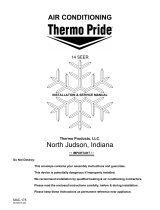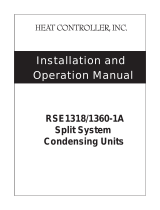! WARNING
These instructions are intended as an aid to qualified, licensed service personnel for proper installation,
adjustment and operation of this unit. Read these instructions thoroughly before attempting installation
or operation. Failure to follow these instructions may result in improper installation, adjustment,
service or maintenance possibly resulting in fire, electrical shock, property damage, personal injury
or death.
This product is designed and manufactured to permit installation in accordance with National Codes. It
is the installer's responsibility to install the product in accordance with National Codes and/or
prevailing local codes and regulations. The manufacturer assumes no responsibility for equipment installed
in violation of any codes or regulations.
The United States Environmental Protection Agency (EPA) has issued various regulations regarding
the introduction and disposal of refrigerants in this unit. Failure to follow these regulations may harm
the environment and can lead to the imposition of substantial fines. Because these regulations may vary
due to the passage of new laws we suggest that any work on this unit be done by a certified technician.
Should you have any questions please contact the local EPA office.
The manufacturer's warranty does not cover any damage or defect to the air conditioner caused by the
attachment or use of any components, accessories or devices (other than those authorized by the manufacturer)
into, onto, or in conjunction with the air conditioner. You should be aware that the use of unauthorized
components, accessories or devices may adversely affect the operation of the air conditioner and
may also endanger life and property. The manufacturer disclaims any responsibility for such loss or
injury resulting from the use of such unauthorized components, accessories or devices.
Attach the service panel to the outdoor unit securely. If the service panel is not attached securely, it
could result in a fire or an electric shock due to dust, water, etc.
These instructions are intended as an aid to qualified, licensed service personnel for proper installation,
adjustment and operation of this unit. Read these instructions thoroughly before attempting installation
or operation. Failure to follow these instructions may result in improper installation, adjustment,
service or maintenance possibly resulting in fire, electrical shock, property damage, personal injury
or death.
This product is designed and manufactured to permit installation in accordance with National Codes. It
is the installer's responsibility to install the product in accordance with National Codes and/or
prevailing local codes and regulations. The manufacturer assumes no responsibility for equipment installed
in violation of any codes or regulations.
The United States Environmental Protection Agency (EPA) has issued various regulations regarding
the introduction and disposal of refrigerants in this unit. Failure to follow these regulations may harm
the environment and can lead to the imposition of substantial fines. Because these regulations may vary
due to the passage of new laws we suggest that any work on this unit be done by a certified technician.
Should you have any questions please contact the local EPA office.
The manufacturer's warranty does not cover any damage or defect to the air conditioner caused by the
attachment or use of any components, accessories or devices (other than those authorized by the manufacturer)
into, onto, or in conjunction with the air conditioner. You should be aware that the use of unauthorized
components, accessories or devices may adversely affect the operation of the air conditioner and
may also endanger life and property. The manufacturer disclaims any responsibility for such loss or
injury resulting from the use of such unauthorized components, accessories or devices.
Attach the service panel to the outdoor unit securely. If the service panel is not attached securely, it
could result in a fire or an electric shock due to dust, water, etc.
Message to Owner
These instructions should be carefully read and kept near the product for future reference. While the instructions are
addressed primarily to the installer, useful maintenance information is included. Have your installer acquaint you with
the operating characteristics of the product and periodic maintenance requirements.



















